Construction Technology and Pavement Performance of Dry-Mix Polyurethane Modified Asphalt Mixtures: A Case Study
Abstract
:1. Introduction
2. Background of the Trail Pavement
3. Materials and Methods
3.1. Raw Materials
3.2. Mixing Parameters
3.3. Proportion Design of the Mixture
3.4. Construction of the Trial Pavement
4. Test Methods
4.1. Laboratory Test of Pavement Performance
4.2. Fourier Transform Infrared Spectroscopy (FTIR) Test
4.3. Field Test of Pavement Performance
5. Results and Discussion
5.1. Optimization of the Construction Technology
5.1.1. Mixing Temperature
5.1.2. Mixing Time
5.1.3. Hitting Number
5.2. Chemical Reactions in PUA Systems
5.3. Laboratory Mixture Pavement Performance
5.3.1. High- and Low-Temperature Performance
5.3.2. Water Stability
5.3.3. Fatigue Resistance
5.4. Trail Pavement Performance
5.5. Construction Cost Analysis
6. Conclusions
- (a)
- The construction technology could significantly affect the mechanical properties of DPAM, and the recommended optimal MTE, MTI, and HN were 160 °C, 60 s, and 75 times, respectively. Compared with SBSAM, the MTE and MTI of DPAM decreased, which contributed to the reduction in energy consumption and cost.
- (b)
- The FTIR results suggested a sufficient chemical reaction of the PU in DPAM. DPAM had satisfactory overall pavement performance; although slightly inferior to WPAM in terms of high-temperature performance and water stability, it was significantly better than SBSAM, especially in terms of low-temperature cracking resistance and fatigue performance.
- (c)
- The trial road paved with DPAM met the relevant requirements for construction quality. The cost of DPAM was comparable to that of SBSAM. Still, its simplified construction process and better pavement performance can positively reduce energy consumption, prolong service life, and promote the large-scale application of PUAM in pavement engineering.
- (d)
- The pavement performance and service conditions of the trial road after the operation will continue to be monitored and tested, and the investigation on the performance optimization and micro-mechanism of DPAM will be conducted in the future. Additionally, the Hertzian stresses developed when the DPAM pavement was subjected to distributed loads and the simulation analysis will be carried out in future work.
Author Contributions
Funding
Institutional Review Board Statement
Informed Consent Statement
Data Availability Statement
Conflicts of Interest
References
- Jia, M.; Sha, A.; Jiang, W.; Li, X.; Jiao, W. Developing a solid–solid phase change heat storage asphalt pavement material and its application as functional filler for cooling asphalt pavement. Energy Build. 2023, 285, 112935. [Google Scholar] [CrossRef]
- Chong, D.; Wang, Y.; Dai, Z.; Chen, X.; Wang, D.; Oeser, M. Multiobjective optimization of asphalt pavement design and maintenance decisions based on sustainability principles and mechanistic-empirical pavement analysis. Int. J. Sustain. Transp. 2018, 12, 461–472. [Google Scholar] [CrossRef]
- Sun, J.; Zhang, Z.; Ye, J.; Liu, H.; Wei, Y.; Zhang, D.; Li, X. Preparation and properties of polyurethane/epoxy-resin modified asphalt binders and mixtures using a bio-based curing agent. J. Clean. Prod. 2022, 380, 135030. [Google Scholar] [CrossRef]
- Cui, P.; Xiao, Y.; Fang, M.; Chen, Z.; Yi, M.; Li, M. Residual Fatigue Properties of Asphalt Pavement after Long-Term Field Service. Materials 2018, 11, 892. [Google Scholar] [CrossRef] [PubMed]
- Padhan, R.K.; Sreeram, A. Enhancement of storage stability and rheological properties of polyethylene (PE) modified asphalt using cross linking and reactive polymer based additives. Constr. Build. Mater. 2018, 188, 772–780. [Google Scholar] [CrossRef]
- Li, Y.; Cheng, P.; Siddig, E.A.A.; Han, C. Investigation on thermal aging stability of crosslinked styrene butadiene rubber modified asphalt binder. Road Mater. Pavement Des. 2020, 21, 1902–1917. [Google Scholar] [CrossRef]
- Xu, M.; Zhang, Y.; Zhao, P.; Liu, C. Study on aging behavior and prediction of SBS modified asphalt with various contents based on PCA and PLS analysis. Constr. Build. Mater. 2020, 265, 120732. [Google Scholar] [CrossRef]
- Du, Z.; Jiang, C.; Yuan, J.; Xiao, F.; Wang, J. Low temperature performance characteristics of polyethylene modified asphalts—A review. Constr. Build. Mater. 2020, 264, 120704. [Google Scholar] [CrossRef]
- Huang, G.; Yang, T.; He, Z.; Yu, L.; Xiao, H. Polyurethane as a modifier for road asphalt: A literature review. Constr. Build. Mater. 2022, 356, 129058. [Google Scholar] [CrossRef]
- Cong, L.; Yang, F.; Guo, G.; Ren, M.; Shi, J.; Tan, L. The use of polyurethane for asphalt pavement engineering applications: A state-of-the-art review. Constr. Build. Mater. 2019, 225, 1012–1025. [Google Scholar] [CrossRef]
- de Souza, F.M.; Kahol, P.K.; Gupta, R.K. Introduction to Polyurethane Chemistry. In Polyurethane Chemistry: Renewable Polyols and Isocyanates; American Chemical Society: Washington, DC, USA, 2021; Volume 1380, pp. 1–24. [Google Scholar]
- Zhang, J.; Hori, N.; Takemura, A. Influence of NCO/OH ratio on preparation of four agricultural wastes liquefied polyols based polyurethane foams. Polym. Degrad. Stab. 2020, 179, 109256. [Google Scholar] [CrossRef]
- Anbarlouie, M.; Mahdikhani, M.; Maleki, A. The contribution of encapsulated polyurethane adhesive in improving the static torsional resistances of self-healing concrete beam comparing bonded FRP technique. Constr. Build. Mater. 2018, 191, 904–911. [Google Scholar] [CrossRef]
- McCreath, S.; Boinard, P.; Boinard, E.; Gritter, P.; Liggat, J.J. High clarity poly(caprolactone diol)-based polyurethane adhesives for polycarbonate lamination: Effect of isocyanate and chain-extender. Int. J. Adhes. Adhes. 2018, 86, 84–97. [Google Scholar] [CrossRef]
- Li, Z.; Yang, F.; Yuan, J.; Cong, L.; Yu, M. Study on preparation and pavement performance of polyurethane modified asphalt based on in-situ synthesis method. Constr. Build. Mater. 2021, 309, 125196. [Google Scholar] [CrossRef]
- Jin, X.; Guo, N.; You, Z.; Wang, L.; Wen, Y.; Tan, Y. Rheological properties and micro-characteristics of polyurethane composite modified asphalt. Constr. Build. Mater. 2020, 234, 117395. [Google Scholar] [CrossRef]
- Huang, T.; Zhang, Z.; Wang, L.; Sun, J.; Wang, Z.; Liu, H.; Chen, L. Study on the compatibility between polyurethane and asphalt based on experiment and molecular dynamics simulation. Case Stud. Constr. Mater. 2022, 17, e01424. [Google Scholar] [CrossRef]
- Jia, M.; Zhang, Z.; Yang, N.; Qi, B.; Wang, W.; Huang, Z.; Sun, J.; Luo, F.; Huang, T. Performance Evaluation of Thermosetting and Thermoplastic Polyurethane Asphalt Mixtures. J. Mater. Civ. Eng. 2022, 34, 04022097. [Google Scholar] [CrossRef]
- Shirzad, S.; Idris, I.I.; Hassan, M.; Mohammad, L.N. Self-Healing Capability and Mechanical Properties of Asphalt Mixtures Prepared with Light-Activated Polyurethane Prepolymer Modified Asphalt Binder. Transp. Res. Rec. 2023, 03611981221138522. [Google Scholar] [CrossRef]
- Sun, M.; Bi, Y.; Zheng, M.; Wang, J.; Wang, L. Performance of Polyurethane Mixtures with Skeleton-Interlocking Structure. J. Mater. Civ. Eng. 2020, 32, 04019358. [Google Scholar] [CrossRef]
- Picado-Santos, L.G.; Capitão, S.D.; Neves, J.M.C. Crumb rubber asphalt mixtures: A literature review. Constr. Build. Mater. 2020, 247, 118577. [Google Scholar] [CrossRef]
- Tahami, S.A.; Mirhosseini, A.F.; Dessouky, S.; Mork, H.; Kavussi, A. The use of high content of fine crumb rubber in asphalt mixes using dry process. Constr. Build. Mater. 2019, 222, 643–653. [Google Scholar] [CrossRef]
- JTG F40-2004; Ministry of Transport of China. Technical Specification for Construction of Highway Asphalt Pavements. China Communications Press: Beijing, China, 2004.
- Zhang, J.; Chen, M.; Wu, S.; Zhou, X.; Zhao, G.; Zhao, Y.; Cheng, M. Evaluation of VOCs inhibited effects and rheological properties of asphalt with high-content waste rubber powder. Constr. Build. Mater. 2021, 300, 124320. [Google Scholar] [CrossRef]
- Zhang, Q.; An, Z.; Huangfu, Z.; Li, Q. A Review on Roller Compaction Quality Control and Assurance Methods for Earthwork in Five Application Scenarios. Materials 2022, 15, 2610. [Google Scholar] [CrossRef] [PubMed]
- JTG E20-2011; Ministry of Transport of China. Highway Engineering Asphalt and Asphalt Mixture Test Regulations. China Communications Press: Beijing, China, 2011.
- JTG 3450-2019; Ministry of Transport of China. Field Test Methods of Highway Subgrade and Pavement. China Communications Press: Beijing, China, 2019.
- Fakhri, M.; Amoosoltani, E.; Aliha, M.R.M. Crack behavior analysis of roller compacted concrete mixtures containing reclaimed asphalt pavement and crumb rubber. Eng. Fract. Mech. 2017, 180, 43–59. [Google Scholar] [CrossRef]
- Lai, Y.; Kuang, X.; Yang, W.-H.; Wang, Y.; Zhu, P.; Li, J.-P.; Dong, X.; Wang, D.-J. Dynamic Bonds Mediate π-π Interaction via Phase Locking Effect for Enhanced Heat Resistant Thermoplastic Polyurethane. Chin. J. Polym. Sci. 2021, 39, 154–163. [Google Scholar] [CrossRef]
- Chattopadhyay, D.K.; Webster, D.C. Thermal stability and flame retardancy of polyurethanes. Prog. Polym. Sci. 2009, 34, 1068–1133. [Google Scholar] [CrossRef]
- Yan, X.; Wu, D.; Hu, K.; Zhang, W.; Xing, J.; Cui, L.; Shi, S.; Yang, J.; Yang, C. The Modification Mechanism, Evaluation Method, and Construction Technology of Direct-to-Plant SBS Modifiers in Asphalt Mixture: A Review. Polymers 2023, 15, 2768. [Google Scholar] [CrossRef]
- Zheng, W.; Wang, H.; Chen, Y.; Ji, J.; You, Z.; Zhang, Y. A review on compatibility between crumb rubber and asphalt binder. Constr. Build. Mater. 2021, 297, 123820. [Google Scholar] [CrossRef]
- Lin, B.; Shi, L.; Zhang, X.; Liang, H.; Wang, D. Study on meso-structural characteristics and homogeneity of asphalt mixture skeleton contacts. Case Stud. Constr. Mater. 2022, 17, e01277. [Google Scholar] [CrossRef]
- Pasandín, A.R.; Pérez, I. The influence of the mineral filler on the adhesion between aggregates and bitumen. Int. J. Adhes. Adhes. 2015, 58, 53–58. [Google Scholar] [CrossRef]
- Xu, Y.; Li, Y.; Duan, M.; Ji, J.; Xu, S. Compaction Characteristics of Single-Component Polyurethane Mixtures. J. Mater. Civ. Eng. 2021, 33, 04021221. [Google Scholar] [CrossRef]
- Ding, Y.; Xi, Y.; Gao, H.; Wang, J.; Wei, W.; Zhang, R. Porosity of municipal solid waste incinerator bottom ash effects on asphalt mixture performance. J. Clean. Prod. 2022, 369, 133344. [Google Scholar] [CrossRef]
- Wang, C.; Huang, S.; Chen, Q.; Ji, X.; Duan, K. Materials, preparation, performances and mechanism of polyurethane modified asphalt and its mixture: A systematic review. J. Road Eng. 2023, 3, 16–34. [Google Scholar] [CrossRef]
- López-Montero, T.; Miró, R. Differences in cracking resistance of asphalt mixtures due to ageing and moisture damage. Constr. Build. Mater. 2016, 112, 299–306. [Google Scholar] [CrossRef]
- Behiry, A.E.A.E.-M. Laboratory evaluation of resistance to moisture damage in asphalt mixtures. Ain Shams Eng. J. 2013, 4, 351–363. [Google Scholar] [CrossRef]
- JTG (2016) 24-2016; Ministry of Transport of China. Specification for Quality Acceptance of Highway Construction. China Communications Press: Beijing, China, 2016.

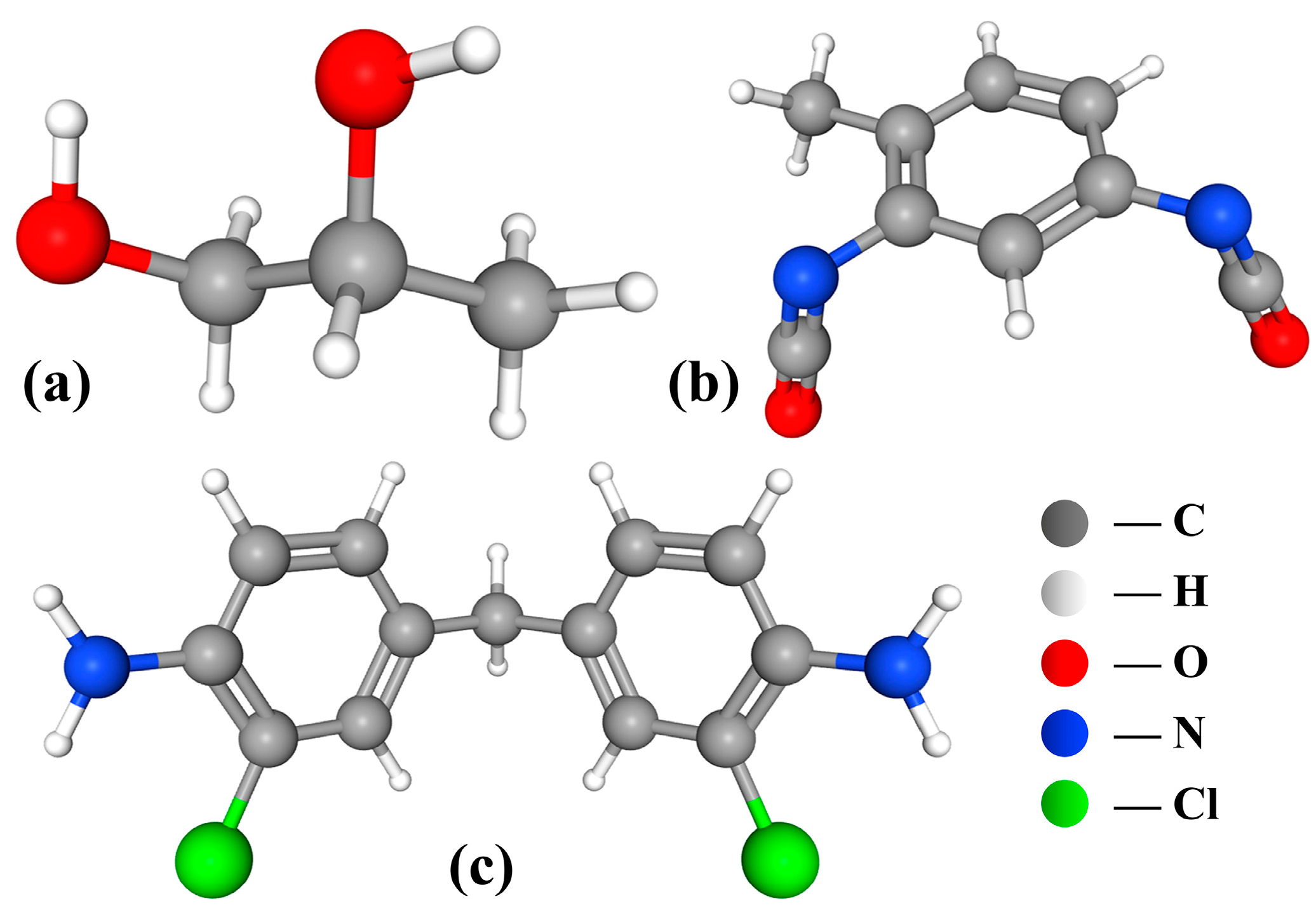




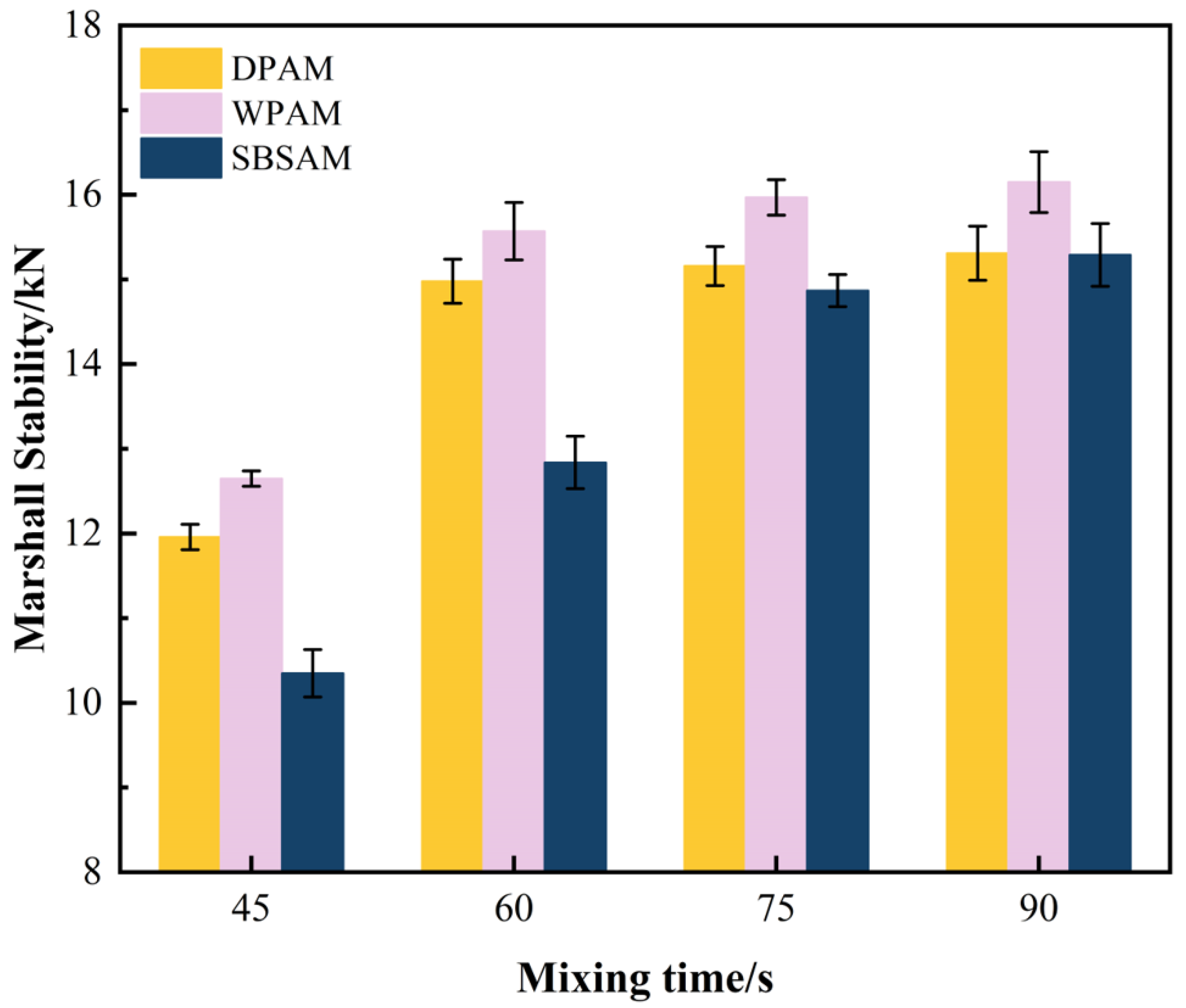

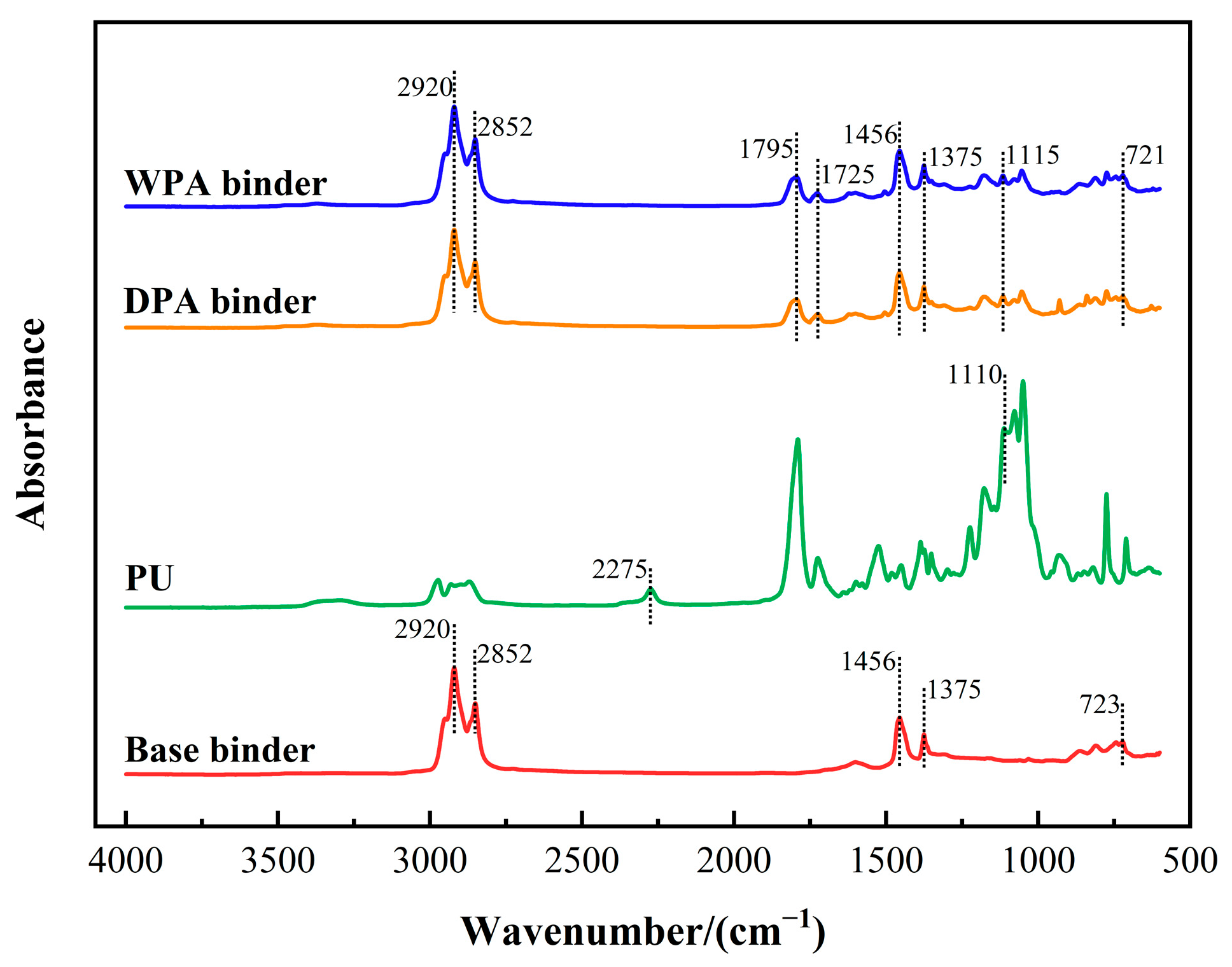

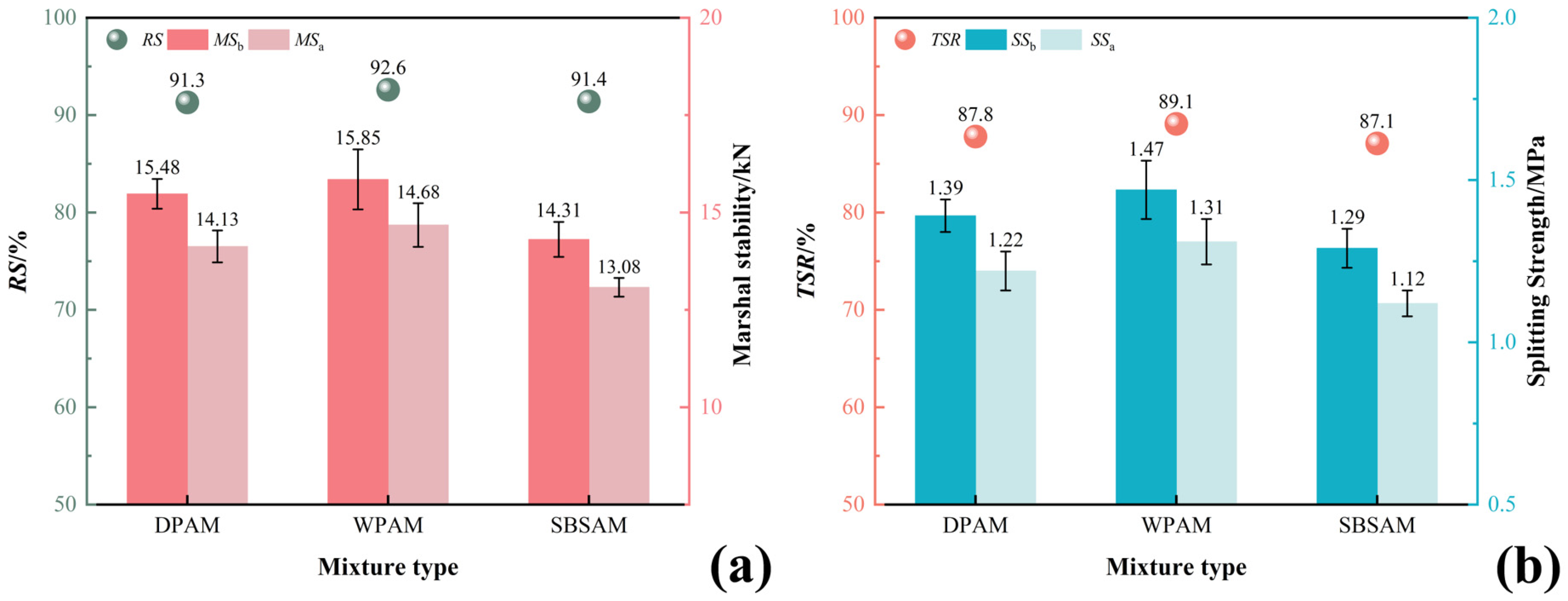

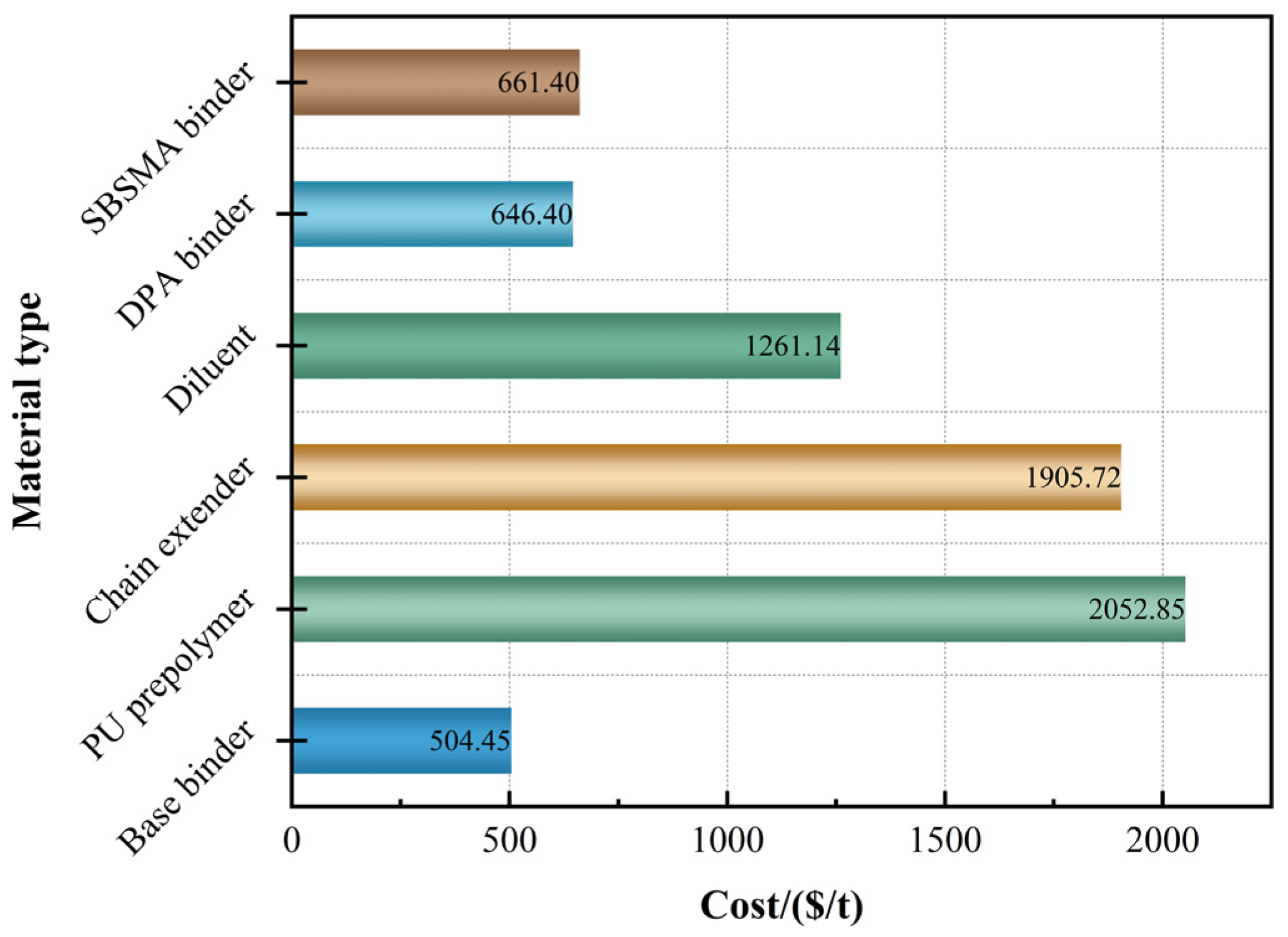
| Test Item | Base Binder | SBS-Modified Asphalt Binder | |||
|---|---|---|---|---|---|
| Result | Specification | Result | Specification | ||
| Penetration (25 °C,100 g, 5 s)/(0.1 mm) | 81 | 80–100 | 68 | 60–80 | |
| Ductility (10 °C for base binder and 5 °C for SBS binder, 5 cm/min)/cm | 92 | ≥20 | 37.2 | ≥30 | |
| Softening point/°C | 48.0 | ≥45 | 83.5 | ≥55 | |
| Dynamic viscosity (60 °C)/Pa·s | 204.8 | ≥245 | - | — | |
| Kinetic viscosity (135 °C)/Pa·s | - | - | 2.4 | ≤3 | |
| Density (25 °C)/(g/cm3) | 1.022 | - | 1.026 | - | |
| After RTFOT | Mass loss/% | −0.242 | ≤±0.8 | −0.246 | ≤±1.0 |
| Penetration ratio (25 °C)/% | 73.1 | ≥57 | 76.5 | ≥60 | |
| Ductility (10 °C for base binder and 5 °C for SBS binder)/cm | 10 | ≥8 | 24 | ≥20 | |
| Material Type | Technical Specification |
|---|---|
| PU prepolymer | Viscosity (85 °C): 230 mPa·s; -NCO ratio: 4.3 ± 0.2%; Density (25 °C): 1.08 g/cm3 |
| Chain extender | Melting point: 98–102 °C; moisture content: <0.3%; amine value: 7.4–7.6 mmol/g; free phenylamine: <1.00%; acetone insoluble matter: <0.04%; density (25 °C): 1.44 g/mol |
| Diluent | Exterior: colorless transparent liquid; moisture content: <0.05%; acetone insoluble matter: <0.04%; flash point: >120 °C; density (25 °C):1.17 g/mL |
| Aggregate Type | Technical Performance | ||||||
|---|---|---|---|---|---|---|---|
| Apparent Density/(g/cm3) | Hygroscopic Rate/% | Soundness/% | Abrasion Value/% | Crush Value/% | Adhesion Grade | ||
| Result | 9.5–13.2 mm | 3.036 | 0.8 | 4.7 | 15.8 | 12.5 | 5 |
| 4.75–9.5 mm | 3.018 | 0.8 | |||||
| 2.36–4.75 mm | 3.031 | 0.9 | |||||
| Specification | ≥2.6 | ≤2.0 | ≤12 | ≤26 | ≤28 | ≥4 | |
| Aggregate Type | Technical Performance | ||
|---|---|---|---|
| Test Item | Result | Specification | |
| Fine aggregate | Apparent density/(g/cm3) | 2.753 | ≥2.5 |
| Methylene blue value/(g/kg) | 1.4 | ≤2.5 | |
| Soundness/% | 6.0 | ≤12 | |
| Angularity/s | 42 | ≥30 | |
| Sand equivalent/% | 72 | ≥60 | |
| Mineral powder | Apparent density/(g/cm3) | 2.708 | ≥2.5 |
| Hydrophilic coefficient | 0.6 | <1.0 | |
| Plasticity index/% | 2 | <4 | |
| Hygroscopic rate/% | 0.3 | ≤1.0 | |
| Test Item | Test Result | Specification |
|---|---|---|
| Thickness/cm | 4.1 | 4.0 |
| Martensian compactness/% | 98.8 | ≥98 |
| Theoretical compactness/% | 94.8 | ≥94 |
| Texture Depth/mm | 1.0 | ≥0.6 |
| International Roughness Index IRI/(m/km) | 0.62 | ≤2.0 |
| Pavement permeability coefficient/(ml/min) | 57 | ≤100 |
Disclaimer/Publisher’s Note: The statements, opinions and data contained in all publications are solely those of the individual author(s) and contributor(s) and not of MDPI and/or the editor(s). MDPI and/or the editor(s) disclaim responsibility for any injury to people or property resulting from any ideas, methods, instructions or products referred to in the content. |
© 2023 by the authors. Licensee MDPI, Basel, Switzerland. This article is an open access article distributed under the terms and conditions of the Creative Commons Attribution (CC BY) license (https://creativecommons.org/licenses/by/4.0/).
Share and Cite
Sun, J.; Zhang, S.; Liu, Y.; Zhang, Z.; Liu, X.; Zhang, Z.; Ban, X. Construction Technology and Pavement Performance of Dry-Mix Polyurethane Modified Asphalt Mixtures: A Case Study. Sustainability 2023, 15, 13635. https://doi.org/10.3390/su151813635
Sun J, Zhang S, Liu Y, Zhang Z, Liu X, Zhang Z, Ban X. Construction Technology and Pavement Performance of Dry-Mix Polyurethane Modified Asphalt Mixtures: A Case Study. Sustainability. 2023; 15(18):13635. https://doi.org/10.3390/su151813635
Chicago/Turabian StyleSun, Jia, Suyu Zhang, Yichen Liu, Zengping Zhang, Xiaosong Liu, Zhihan Zhang, and Xiaoyi Ban. 2023. "Construction Technology and Pavement Performance of Dry-Mix Polyurethane Modified Asphalt Mixtures: A Case Study" Sustainability 15, no. 18: 13635. https://doi.org/10.3390/su151813635
APA StyleSun, J., Zhang, S., Liu, Y., Zhang, Z., Liu, X., Zhang, Z., & Ban, X. (2023). Construction Technology and Pavement Performance of Dry-Mix Polyurethane Modified Asphalt Mixtures: A Case Study. Sustainability, 15(18), 13635. https://doi.org/10.3390/su151813635







